|
The Janus Point— that moment when you’re in the door frame. You’re neither in nor out. You’re at the place of transition. Janus was an ancient Roman god. He had two faces looking opposite each other. He was the god of doorways. He was the god of beginnings. January is named after him. The Janus Point is the moment of key transition, that moment where we anticipate the new beginning.
For UFOlogy, the Second Great UFO Flap (1965-’67) is the Janus Point. We leave off an old phase and enter a new phase, the one that began sculpting the UFO experience into its current form. The old 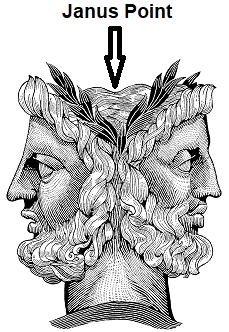 phase was one of silver discs flitting about the sky. There was something ethereal about them, far away, fleeting. With the Second Great Flap, there was something very tangible to UFOs. They were bright lights. They came in close, they hovered, they glowed radiantly. They haunted rural nights and country roads. Sometimes a craft could be seen. phase was one of silver discs flitting about the sky. There was something ethereal about them, far away, fleeting. With the Second Great Flap, there was something very tangible to UFOs. They were bright lights. They came in close, they hovered, they glowed radiantly. They haunted rural nights and country roads. Sometimes a craft could be seen.
The change, as we have seen in Lightcraft and Lightcraft II Significance, came from the operation of Lightcraft type devices. Their operation and purpose, however, remain somewhat obscure. We only understand the effect: it impressed upon society that UFOs were real and unexplainable.
The Great Flap of 1965-1967 is the greatest pitfall in the history of UFO research. Following the flap believing these glowing, hovering lights were real alien spacecraft leads only to the quagmire of today.
On our journey forward, we are now passing the juncture of The Great Flap of 1965-1967 again. In deference to the title of this page, we need to look along our shoulders at the door frame, at the point of transition. In other words, we must look at many more reports in order to amplify Lightcraft as the culprit. 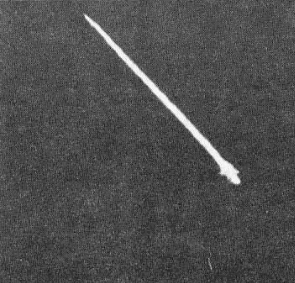 We need to do this so that we cannot be deceived by future encounters with the technology. We must also look at it for another reason. We must begin to reveal the dark side. We need to do this so that we cannot be deceived by future encounters with the technology. We must also look at it for another reason. We must begin to reveal the dark side.
In earlier pages, we have established the flap began as the Western Flap. It becomes traceable in the early morning hours of August 1, 1965, with 9 glowing objects over Francis E. Warren AFB near Cheyenne, Wyoming. NORAD had no explanation for them. Base personnel were calling Project Blue Book in Ohio and reporting the UFOs’ phenomenal actions. Five of the nine finally headed back west, and the other four seem to have split up eastward.
Photo by Judy Hatcher, August 3, 1965.
Thereafter something tangible was being seen over America’s heartland. It was happening essentially only at night. Thousands of people were seeing something, the press was following it, and photographs were being taken.
Amateur astronomer and photographer Judy Hatcher (17) watched a remarkable UFO near Valentine, Nebraska, on August 3, 1965. Her friend, Bill Ward, had drawn her attention to it. She had her scope set up and was able to photograph it. Black and White doesn’t do it justice, but it captures the tangibility of the object they saw. Her description, however, brings it to life. Coral Lorenzen writes up her description (Aug-Sept 1965 Bulletin):
The object was star-like in appearance, except for the fact that it moved up and down and did other maneuvers in relation to some power lines, with maneuvers covering about 12 degrees. There were no stars close enough to which the movement could be related, and a telescope revealed no telescopic stars in the vicinity. The object dimmed frequently, to the extent that it could no longer be seen by naked eye or telescope. It changed colors, varying from red to green to blueish-white. The colors were visible with the naked eye and with telescope and binoculars. An observation of the subject out of focus in the scope showed that the colors moved across the object from side to side, or from top to bottom, or vice versa. The colors were not all present at the same time, in a shifting pattern, as in stars. After this one went through some rapid and extreme changes in color and brightness, another object blinked on in the northeast. It was noted that if one blinked excessively, the other would disappear. After about three hours the original object blinked off and failed to reappear. Miss Hatcher tried three photos of this object through the telescope, and succeeded on two of them. It was noted that all the major stars were in place, including Arcturus, but that no star of less than second magnitude was visible in the vicinity of the object. Object sighted in northeast performed same maneuvers, dimming and color changes as first one. Generally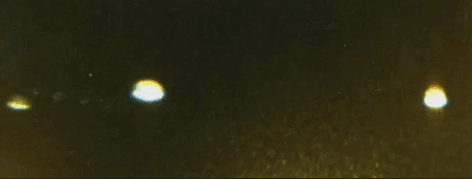 proceeding east slowly and four smaller and dimmer objects appeared to be following and attempting to close ranks with it. proceeding east slowly and four smaller and dimmer objects appeared to be following and attempting to close ranks with it.
Lightcraft in action over Kirtland AFB, 1978, as photographed by Paul Bennewitz. A 12-foot bell on low power (dimmer) follows one of the larger 25-foot type. The leading object appears to be another 12-foot bell on higher power output. Consult Dulce Base by Greg Valdez. Two Lightcraft in action off Florida in 2009.
Miss Hatcher’s descriptions also fit the actions of the craft that landed at Levelland. It would glow many different colors depending on its speed and power output, and then when it wanted it could even “wink out” suddenly and still remain in flight.
The Western Flap soon expanded by late August and into September into a confined section of New England. At the end of September (30th), 1965, that momentous September that gave us the Incident at Exeter, New Hampshire, newsman Ken Skinner (of the local Norwich Bulletin) in nearby Connecticut saw a UFO and photographed it. Again, the black and white frame comes to life when Skinner describes what he saw. “ ‘It was like a brilliant light bulb in the center, then a glow all around it,’ Skinner said. At various times it looked bluish-green, then orange, gray and blue, Skinner reported. Although the object 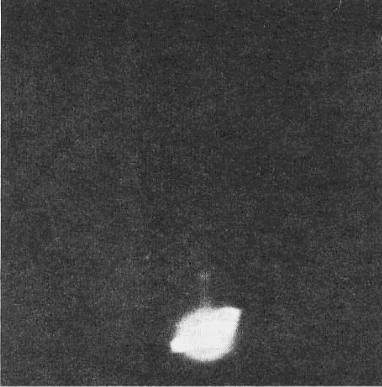 seemed to be very high in the sky it was much larger than a star and at one point it moved across the face of the moon, creating an effect something like an eclipse, he told Associated Press. Skinner said he hadn’t had a drink before making the sighting, ‘But, boy, I feel like one now.’” A.P.R.O.’s Coral Lorenzen adds: “The photograph has been examined by our photo analyst, John Hopf, and is considered to be authentic.” seemed to be very high in the sky it was much larger than a star and at one point it moved across the face of the moon, creating an effect something like an eclipse, he told Associated Press. Skinner said he hadn’t had a drink before making the sighting, ‘But, boy, I feel like one now.’” A.P.R.O.’s Coral Lorenzen adds: “The photograph has been examined by our photo analyst, John Hopf, and is considered to be authentic.”
Left, Ken Skinner’s photo.
The glowing object in Skinner’s photo remarkably resembles the illustration drawn by deputy Dale Spaur of the UFO he and 3 other law enforcement officers sighted. In Spaur’s case, he and his partner Wilbur Neff chased it for 80 miles across Ohio and into Pennsylvania. This was one of the most remarkable sightings of the Second Great UFO Flap and came during the Congressional hearings inspired by the starkly vivid UFO sightings over Dexter and Hillsdale Michigan in late March 1966. It is worth a more detailed look here.
It was dark pre dawn, the early morning of April 17, 1966, near Deerfield/Atwater, Ohio. Coming over the woods was a low flying glowing UFO. Deputies Spaur and Neff were by their patrol car. The object was so bright they had to look down. It hovered nearby and made a humming sound. They jumped in their patrol car for protection. The glow of the object moved over the landscape, indicating the object was gliding away. Spaur called headquarters. He told them they were pursuing it. This they did, keeping it in sight as it flew over the terrain at a modest altitude.
It was flying slowly toward Pennsylvania, and they followed as best they could along the road. After 40 miles, another officer saw it. This was Wayne Huston. After the UFO passed him, he joined the pursuit. His description matched Spaur’s: “I watched it go right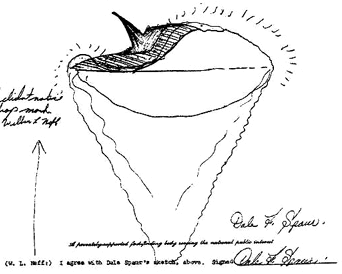 overhead. As near as I can describe it, it was shaped something like an ice cream cone. The point of the cone was underneath; the top was like a dome.” overhead. As near as I can describe it, it was shaped something like an ice cream cone. The point of the cone was underneath; the top was like a dome.”
Spaur’s drawing— a dome with an antenna surrounded by a glow and a downward plasma.
Both police cruisers were doing 85 mph to maintain visual contact with the object. After yet another 40 miles of the chase, while near Freedom, PA, they passed a Pennsylvania policeman standing by his cruiser. It was officer Frank Panzarella. He had been watching it for 10 minutes. “It was very bright and about 25 to 30 feet in diameter. The object then moved out and went straight up real fast to 3,500 feet . . .it continued to go up until it got as small as a ballpoint pen . . .we all four watched the object shoot straight up and disappear.”
The downward glowing cone appeared to be nothing but glowing light, some ionization coming from the object. Some form of this glowing vapor can be seen in the photo by Ken Skinner taken on September 30th of the year before. It can be more readily seen in the picture taken near Fargo, North 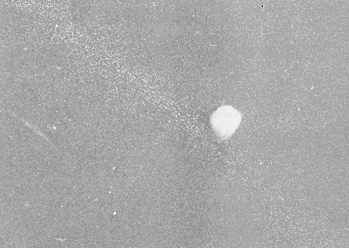 Dakota, on February 25, 1967, of another very similar UFO. Dakota, on February 25, 1967, of another very similar UFO.
This photo was taken near Fargo, North Dakota, on February 25, 1967. The downward cone of light and the round dome is clearly evident. The dome does appear to have a flange around it, which is directing the ionization vapor downward in a cone shape.
What exactly did this object look like? According to Spaur, the solid part of the UFO was shaped like a dome. The cone was merely glowing energy directed downward from it. Despite some fanciful illustrations to create a traditional looking flying saucer, the object seems more to have been something very reminiscent of the object hovering over Dexter and described clearly and, of course, this can be matched to the 25-foot Lightcraft hemisphere. However, the photo taken over Fargo, which is apparently of the same craft the lawmen chased, does reveal a flange has been added around its base. Thus, yes, it essentially looks like a domed flying saucer.
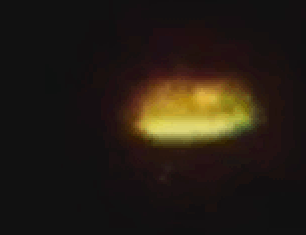
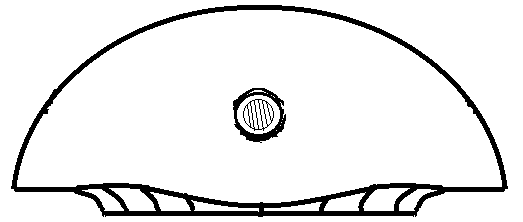 
Top, the 25-foot hemisphere shaped Lightcraft in action. Above, the illustrations show the design modified, right, with a flange. This essentially approximates what what is in the photos above and what was seen in flight by the Ohio lawmen. Without the flange, the ionization could not have been directed into a neat cone downward.
Here begins to enter the dark side. There could be no other purpose in modifying a Lightcraft with a flange except to make it look like a flying saucer. And naturally this would favor the popular theory these “UFOs” were from outer space.
Dale Spaur wouldn’t back down from his description. This was a real object, he insisted. Since he was most vocal, the press concentrated on him, making it look like he was the only witness rather than one of four lawmen who saw it. Eventually, his life was ruined. Divorce, alcohol, leaving the force, all 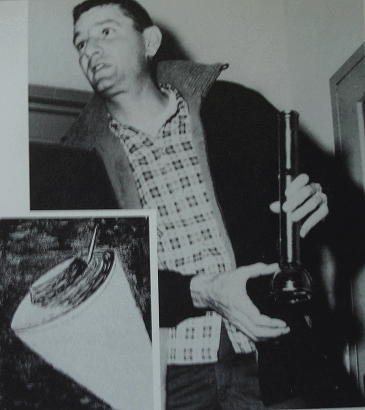 ensued. From the very beginning of reporting this UFO, in fact, he and Neff had unusual difficulty being taken seriously. He was soon interrogated by Major Hector Quintanilla, who was chief of Project Blue Book. The excerpt below, preserved faithfully by J. Allen Hynek, then consultant for Blue Book, indicates what Spaur and Neff went through and Quintanilla’s attitude toward them. ensued. From the very beginning of reporting this UFO, in fact, he and Neff had unusual difficulty being taken seriously. He was soon interrogated by Major Hector Quintanilla, who was chief of Project Blue Book. The excerpt below, preserved faithfully by J. Allen Hynek, then consultant for Blue Book, indicates what Spaur and Neff went through and Quintanilla’s attitude toward them.
Fanciful artwork turned the domed object into a sleek hat-like UFO, but here Spaur equates the object to resembling the end of his policeman’s flashlight.
According to Hynek: “The original investigation was perfunctory; the initial inquiry, made of only one witness, Spaur, was a two and one-half minute phone call, which, according to Spaur, began with the words, ‘Tell me about this mirage you saw.’ The second interview, also by phone, lasted only one and one-half minutes. According to a signed statement by Spaur, Quintanilla apparently wanted Spaur to say he had seen the UFO for only a few minutes; when told that it had been in sight almost continuously while the observers chased it from Ohio into Pennsylvania, a distance of some 60 miles, he quickly terminated the discussion.”
Hynek condemned Quintanilla’s methods as simplistic, an attempt to disregard anything that contradicted his hypothesis that all UFO reports were misidentifications Quintanilla had written off the Spaur/Neff sighting as chasing Venus or some satellite. However, due to the extensive media scrutiny and the Congressional hearings, Congress got involved and Quintanilla had to go interview Spaur and Neff in person.
SPAUR: . . .I’m under the impression that Venus rises out of the east, as the morning star. And this is probably another thing that’s wrong, I’m not sure.”
QUINTANILLA: Depends, depends.
S: Huh?
Q: Sometimes it’ll rise right over you.
S: Oh. O.K. So anyway. . .
Q: Venus, Venus— Venus today [papers rattling] rises at 2:49 in the morning. And it rises 150 degree azimuth and 25 degree elevation. It doesn’t have to rise low on the horizon; it can rise high. But it’s on the ecliptic, yes.
S: O.K., so it’s on the ecliptic. Granted you have this. Now this, this thing is this large; this big, and this low, and these people watched this thing from over in the Mogadore area; they report it, and I follow it, and I have Barney with me. We’re going down the road; so you’re going to discount, well, there’s two nuts; we’re running Venus. Now Venus. . .
Q: Now, wait a minute. . .
S: Well, wait a minute, let me speak. . .
Q: You used the wrong word. . .
S: O.K. Well. . .
Q: I’m an officer in the United States Air Force. . .
S: Right. You definitely are. . .
Q: And I don’t call anybody a nut.
S: No, O.K. I have hallucinations then! But this is what I’ve been saying. . .
Q: I didn't say you were having hallucinations.
S: What I’m trying to say is this I’m going down the road; now this thing that I am following. . .
Q: And treat me with the same respect that I treat you.
S: I will sir; I’ll treat you with more respect than I’ve been treated the last. . .
Q: I’m not calling you a nut. I’m not saying you had hallucinations.
Even in the face of Congress, what it amounted to was that Quintanilla still dismissed this as a sighting of a satellite or Venus, despite Hynek clearly noting that both men saw Venus at the same time in another part of the sky.
Vindicating Spaur and Neff’s report is that photograph taken near Fargo, North Dakota, on February 25, 1967. This is unquestionably the craft they saw. It was still in operation further west than Ohio close to a year later. However, by this time Spaur had been ridiculed and his life was headed toward the breakers.
The combination of the above is disturbing enough, but when added to the facts below, a palpable darkness falls over The Great Flap of 1965-1967. First, the above combination shows Lightcraft was adjusted with a flange. The end result was obviously to make it look like a flying saucer. Now for the facts below. The “UFO” that Spaur/Neff/Huston chased was on the identical course flown by the Lightcraft bell-capsule on December 9, 1965. Only in its case it did not rise up and wink out. It encountered problems and made a crash landing in the woods near Kecksburg, Pennsylvania.
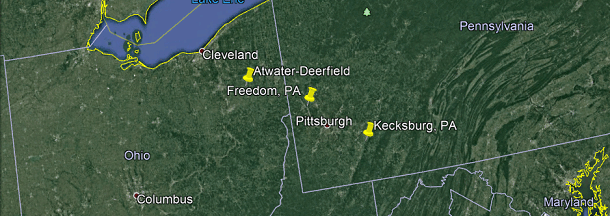
Near Atwater/Deerfield, Ohio, the chase of the UFO began on April 17, 1966. The 4 officers then saw it zoom up past Freedom, PA, and eventually wink out. This would have placed it over Kecksburg, the location 4 months earlier of a crash of a Lightcraft capsule.
Opening up our scope of view reveals that Dexter and Hillsdale, Michigan, are on this route. Frankly, this flight path could also include Fargo, North Dakota. For a couple of years, these craft were following a routine course, in the beginning loitering about at Dexter and Hillsdale. In addition, UFO were frequently being sighted over this part of Pennsylvania, to such an extent that a famous UFO photo forgery was done at Brighton Township (the Lucci photo) that imitated the downward glowing cone. Altogether this suggests Lightcraft was on a rather horrid PsyOp and was following a routine course on its operations.
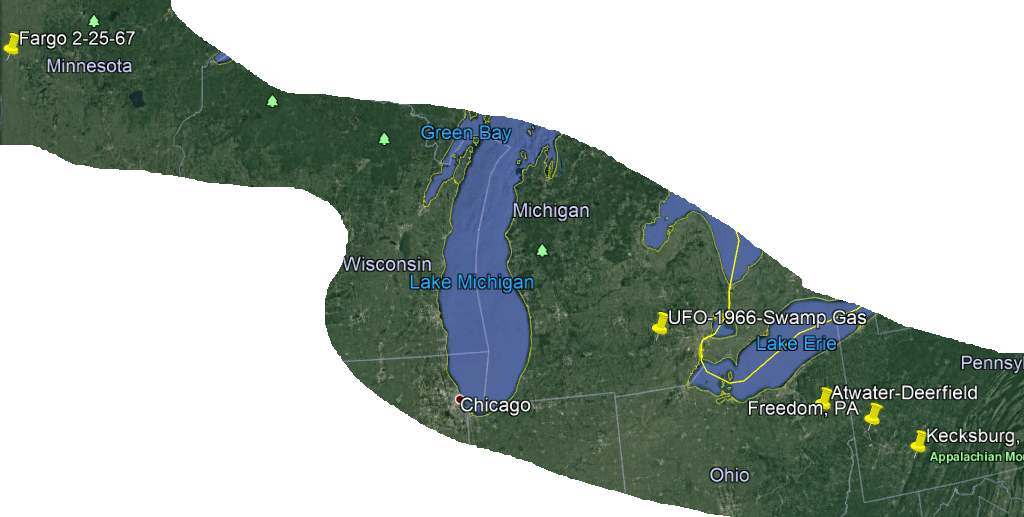
The prime two cases above— Kecksburg and the Spaur/Neff/Huston/Panzarella sightings— put together are the most powerful argument for establishing the modification of Lightcraft. Along this same flight path the bell and dome versions flew. One hovered close-up over Dexter. One had crashed at Kecksburg. The domed saucer version was on an identical course as these known Lightcraft models— the bells and domes— and this makes it impossible to avoid the evidence that Lightcraft devices were modified, in some instances to appear like a 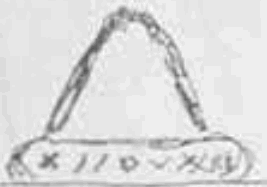 domed flying saucer. More photos (like over Fargo) and the accrued sightings over The Great Flap of 1965-1967 only underscore this deduction. domed flying saucer. More photos (like over Fargo) and the accrued sightings over The Great Flap of 1965-1967 only underscore this deduction.
The Lightcraft capsule as drawn by a witness to the military operations at Kecksburg, PA, December 9, 1965. They picked it up quickly and drove it off on an Army flatbed.
Today, the CIA is quite open about blaming UFO reports in the 1960s on US spy craft, usually citing high flying U-2 aircraft. Any hint of intentionality, that is, intending to create the image UFOs were ET craft is avoided, including any reference to Lightcraft. U-2 flights, of course, don’t fit the low altitude sightings or the observed and dynamic maneuvers of the 1960s’ glowing UFOs, which included hovering, ascending and descending vertically, winking out, and zooming in and away with incredible speeds, all aerodynamics of which U-2 is incapable.
It is clear from the basic design that Lightcraft are not dependent on aerodynamic and avionic forms and limitations. They don’t appear to have any moving parts. As such the basic capsule/bell is capable of being adapted to various silhouettes. All it would take is a flange around either of the two basic designs. These potential designs will be developed in Lightcraft IV: Descent into Darkness. But here a further glimpse is necessary.
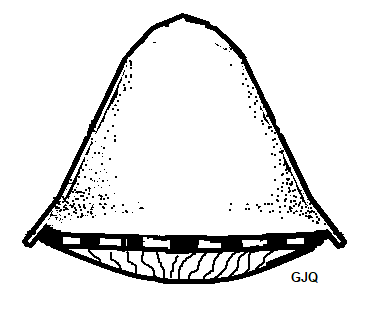 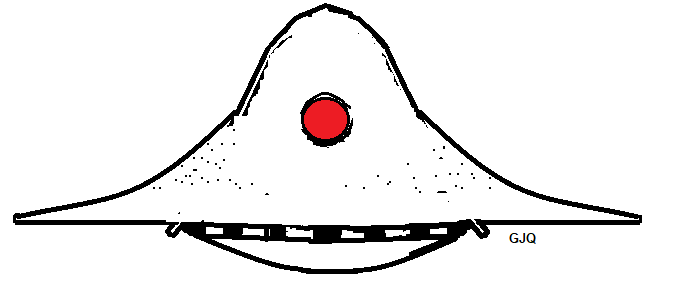
Above, just one example of how Lightcraft’s basic bell (capsule) can be theoretically modified with a flange to create a rather popular impression of a flying saucer. Below, left, taking the angle of the Dexter, Michigan, UFO, as presented by Lt. Colonel Hector Quintanilla, and adjusting it with a flange gives us a remarkable image.
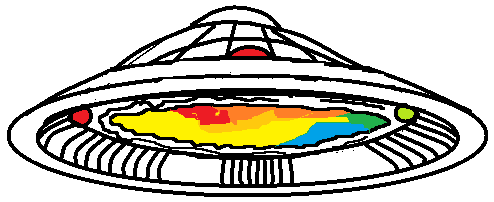 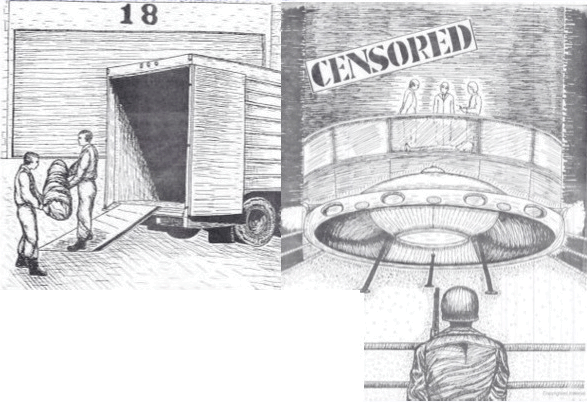
In the 1970s, based on witness reports of seeing such saucers in hangars at Wright-Patterson AFB in Ohio, illustrations began to show flying saucers that looked remarkably like the hemisphere Lightcraft with a flange. Above, right, is only one example. It is the contention here that the witnesses probably saw the secret craft and thought they were alien spaceships.
With just the above illustrative examples, we seem to have several “UFO” models in the air during The Great Flap of 1965-1967 when, in truth, all could be explained by modifications of only two basic models known to exist (at this time).
To amplify the dark side, we must look at some other reports where Lightcraft interacted with lawmen. Another eyewitness description from two policemen comes from Deadwood, South Dakota, on September 22, 1966. J Allen Hynek paraphrases their report:
The policemen observed a large, bright, round white object 50 degrees above the horizon and apparently located between two neighboring towns (as attested by radio reports from these and other locations, which made a rough triangulation possible).The object hung motionless for about 15 minutes, blacking out when the officers shined their spotlights up toward it. They said it was the size of a silver dollar held at arm’s length.
Shortly afterward a smaller object— a light— streaked in toward it from the northwest, moved close to the bright object, and stopped. Then another light streaked in from the southeast and also stopped close by the large light. Then the large light executed a square trajectory, sending occasional blue shafts of light toward the ground. After some 30 minutes of such maneuvering the small lights shot off at high speed in the direction from which they had come, taking about seconds to disappear. No sound was heard.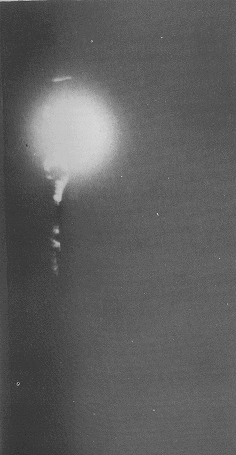
Forging yet another link with earthly design, these “UFOs” behaved like the UFOs reported over the Burbank area in February 1957 (near the Lockheed skunk works). They also behaved like the lights seen by Bill Ward and photographed by Judy Hatcher at Valentine, Nebraska, on 3 August 1965. These exact lights and their behavior will come up again when we get to Phase 3: Ultimate, and there we can firmly establish some are manned and droned craft.
They mimic the objects that would be photographed by Paul Bennewitz in 1978, which are known to be Lightcraft in operation over Kirtland AFB. The Fargo photo is strongly suggestive of the same object the 3 police officers chased over Ohio and into Pennsylvania, the incident that eventually ruined Spaur’s life because he stood by it. All these photos and reports establish the craft operating over a wide territory and responsible for the key moments that forged The Second Great UFO Flap.
Photo, right, by Bob Campbell, Sherman, Texas, August 2, 1965. The color of the plasma being ejected is not recorded. But Lightcraft have been filmed ejecting blue shafts or bolts of glowing plasma.
It is perhaps best to reintroduce Frank Edwards summation of the Great Flap’s beginning here: “The upsurge in prominence for the UFOs in 1966 was the direct outgrowth of their dramatic mass appearances in 1965, culminating in the night of August 2-3, when an estimated quarter of a million persons stood out in the Great Plains states of the United States and watched the formations of unusual lights maneuvering overhead.”
Yet another one of these same UFOs was photographed by newsman Bob Campbell near Sherman Texas, on August 2, 1965. Bolts of glowing plasma (color not mentioned or indicated on B&W film) fall from a brilliant light like that seen in the Lightcraft practices over Kirtland AFB in 1978. This is just one of those 9 UFOs that first appeared over Warren AFB in Wyoming on August 1 and split up over the Midwest. Every description of them fits Lightcraft, indicating once again the high tech wonders were in use over a broad territory and period of time yet never officially divulged as existing.
Over 1965-1967, as far as America, even Congress, was concerned, these were truly unidentified flying objects and therefore potentially alien. UFO buffs, of course, classified them as flying 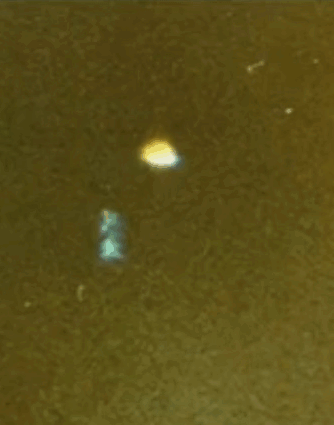 saucers and were grateful. This was the starkest proof they had that visits from outer space were happening. saucers and were grateful. This was the starkest proof they had that visits from outer space were happening.
That the descriptions and photos of these UFOs were accurate is seen in that qualified scientists could explain the observed effects along understood physical processes. For example, in studying these encounters, NASA’s Paul Hill proposed how the cone of ionization beneath the craft could be made. He also explained the shifting colors. Though he thought these could truly be interplanetary, he appears to have been right about the physics involved.
Paul Bennewitz’s photo of a Lightcraft capsule in action over Kirtland AFB, 1978. It has ejected a bolt of cyan plasma. Consult Dulce Base by Greg Valdez.
From all the data, Hill was certain the glowing light and its fuzziness around the UFO was a plasma put in place by the vehicle’s level of radiation. He writes:
“At night, when the witness must see the UFO by its own light, it follows that if the plasma is fully developed (saturated with ions) the plasma can completely obscure the UFO, for the critical distance is small. In the more general case where the UFO is operating at a lower radiation, the witness can see the UFO surface directly ahead, looking normal to the surface through the least amount of plasma. The light reflected from that surface reaches his eye. But when he looks for the outline, he must look obliquely through a greater thickness of plasma. The light from the edge will be partly or all absorbed, making the edge indistinct or invisible. This is why the witness says ‘I’m sure the object was solid, but I could not see its shape.’ If the UFO radiation dies down as the witness watches, the entire UFO becomes visible because the actual plasma thickness becomes less than critical.”
Hill wasn’t proposing any knowledge of UFO propulsion, but he understood how the atmosphere would react to a source of power generating radiation.
“The opaqueness of various plasmas to passing radiation has many counterparts in modern technology. The principle is used in the furnace design of steam turbine-electric power plants which are designed to heat the boiler tubes by gas radiation . . .Another example can be seen in vehicles re-entering the Earth’s atmosphere from orbit or from a lunar trip. While the plasma sheath is at maximum, there is a complete radio communications blackout, for even the radio frequencies can’t pass through the critical plasma thickness. That some are hot and that some are cold makes no difference. The degrees of ionization and excitement is what counts.”
Hill offers this illustration:
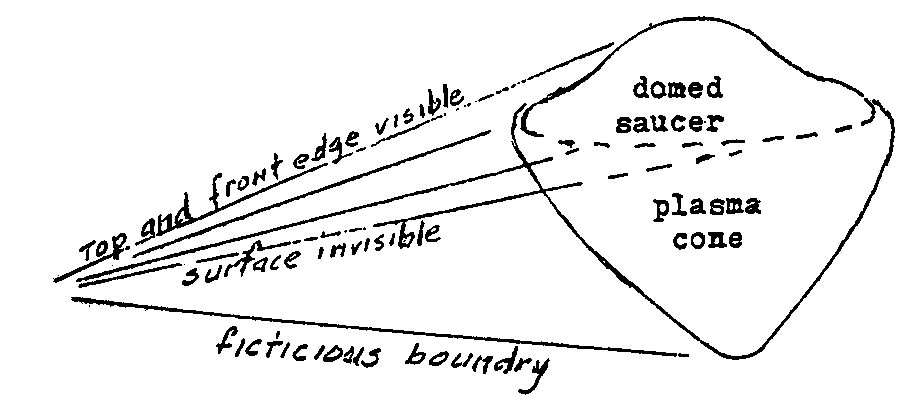
Of the Spaur/Neff sighting, he declares: “The officers said that the vehicle tilted ‘forward’ to start and ‘backward’ to stop. At low speed the cone was symmetric, like the kettledrum case, but at high speed they reported that the cone was swept backward, thus confirming (one more time) that the cone was a plasma, and the UFO a saucer.”
He offers this illustration:
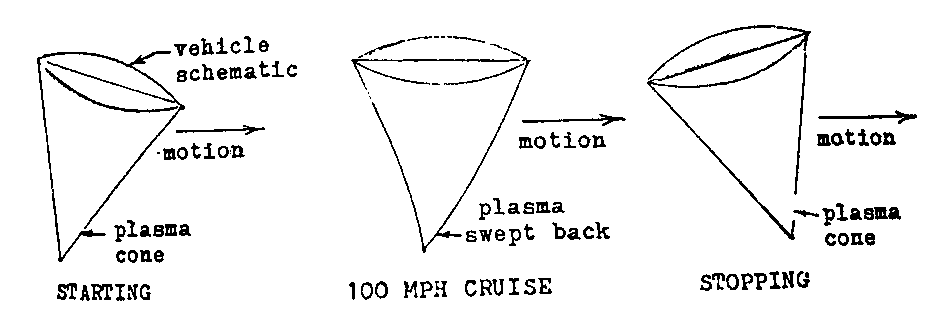
Hill also makes reference to the photograph (toward the top of this page) of the UFO seen over Fargo, North Dakota, and writes that it was “a perfect verification” of the sequence above. “A sharp eye can even see that the plasma in the photo is swept a little to the left, indicating that the domed saucer shown has a component of motion to the right.”
Hill’s dissertation also explains how something like a Lightcraft acorn (12-foot capsule/bell) can appear a flying saucer. Referring again to his first illustration above, the witness only sees what is directly ahead of him. Therefore the witness can see the dome and power rim and assumes it spreads out into a saucer where the plasma is 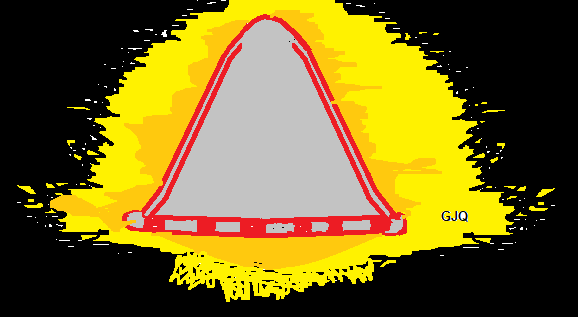 too thick to see the outline of the craft. too thick to see the outline of the craft.
Lightcraft at night— you wouldn’t see the outline of the acorn/capsule, as shown here in gray and red, only the glowing light.
Obviously, Hill was outside of the skunk works projects. He was showing for his reading audience that the UFO descriptions were not outside the bounds of science, but he didn’t seem to suspect it was indeed our own technology.
Hill’s qualified analysis explains much in the sightings beginning with Levelland and continuing through 1965-1967 (and even later as we will see). When operating at low power the device at Levelland was visible. The intense radiation, as evidenced by the colors and thickness of the plasma, would make it impossible at high power for any pilot in such a craft to communicate with the ground or with another Lightcraft type device. Over Valentine, Nebraska, for instance, the witnesses saw the crafts communicating by light signals.
Nevertheless, other principles are involved that need explaining. The objects can shut off all light and thereby suddenly “wink out.” For example, when the officers near Deadwood shined their powerful car spotlights on the object, it blacked out. This contradicts the theory the radiating glow is exclusively reflective of the power output that keeps it in flight.
Paul Hill’s analysis and our own analysis of the photos and descriptions above do call our attention to an obvious fact: more than one type of craft was involved. This would seem to be beyond probability, and it has become standard in UFO lore to promote the idea that the different types of UFOs seen can be explained by more than one ET culture visiting us, each with its own different type of spaceship design. However, analyzing descriptions and flight paths, it is far more probable these UFOs were all basic Lightcraft designs, some modified with a flange. The widespread operation and the motivation for all this is unknown.
Nevertheless, we cannot deny that two other types of UFOs were seen and photographed over this same Great Flap (1965-1967) and one at least is fundamentally different than any modified Lightcraft device.


The top example can easily be a modified Lightcraft type capsule. The thin-flanged saucer was photo’d over Lake Tiorati, New York, December 18, 1966. However, directly above, is an illustration of the UFO seen and photographed by deputy Art Strauch on October 21, 1965, near St. George, Minnesota.
The photo and description by Art Strauch is indeed that of a flying saucer. His photo proves the plasma clung to its actual shape, for the opening of the air scoop remains visible in the photo. Strauch saw enough of it clearly through binoculars to describe its details, and these details were enough to establish its origins as purely earthly technology. The struts leading from the arches of the dome attach to the rim and hold in place a rotating disc underneath. (See Lightcraft II Significance)
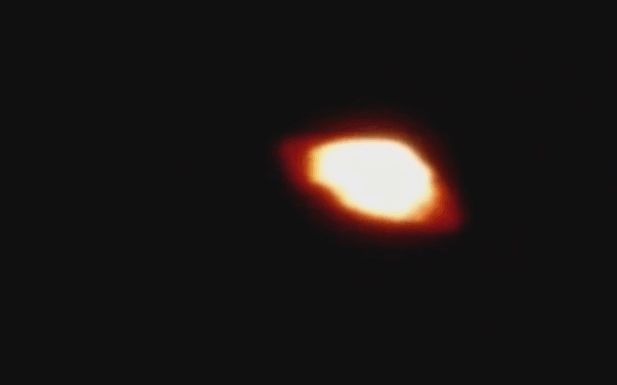 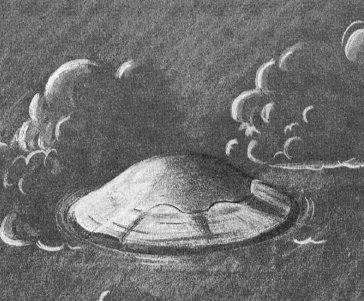
Strauch’s photo, left, shows the air intake represented clearly in the illustration, right, done by Richard Beal, staff illustrator for A.P.R.O.’s Bulletin under Strauch’s supervision. It reflects what he saw through the binoculars. (See Lightcraft: Significance) The plasma glow of the saucer was identical to Lightcraft, but conformed to its domed-disc shape, indicating it was a definitely different design than the bell or hemisphere Lightcraft.
Strauch’s description and picture evokes the reports of the “flying World War I helmet” seen vividly over the US Midwest in 1950. It most certainly predates the Lightcraft capsule design. But it also predates any possibility of an alien saucer crash in 1953, as we explored based on Dr. Robert Sarbacher’s recollections.
Certainly UFO theorists have proposed that saucer technology (from Roswell, of course) has been adapted into secret black projects. Yet there is a real flaw in their theorizing, namely, they don’t know what UFO technology is. Thus there is no way to liken any of our advances to it. We certainly don’t have saucers zipping through the air at 10,000 mph. But this doesn’t mean we don’t understand saucer technology. Already in 1947 General Nathan Twining categorically stated we understood this technology and could build piloted craft that look like saucers.
It would be fun to say that Lightcraft’s exotic technology is the result of backworking a crashed alien flying saucer. But we have to face the fact that we mere humans are the authors of “alien” technology. We may not have needed a crashed alien saucer to backwork. Such phenomenal technology as saucers display may be a basic principle we well understand. It is just that it is so involved and expensive, its full potential may be limited. It is also likely such technology cannot be fully harnessed by higher inertial beings like ourselves.
Years before the advent of Lightcraft technology, novel propulsion technologies were discussed. A Canadian physicist, Dr. Fernand Roussel, had proposed the use of electromagnetic fields for propulsion in a privately printed paper (The Unifying Principle of Physical Phenomenon) about 1943. In 1950, Wilbert B. Smith, another Canadian, took it further into details with Donald Keyhoe, believing that the flying saucers already used magnetic energy to propel themselves. He said the best way to harness the energy from the magnetic field was a “magnetic sink.” This could be accomplished by a design dependent on a central cabin with a rotating disc around it. The recent descriptions (circa 1950) of flying saucers as just such devices convinced him they were using this technology and collapsing the Earth’s magnetic field as a source of propulsion.
The dome with the rotating disc around it has become our quintessential flying saucer. It has become so because the clarity of the sightings involving it are without equal and they began early-on, about 1949. Much evidence can be put in place establishing its very earthly origins and that the reports of flying saucers in 1947 actually inspired its very secretive and independent development. More than one of this kind of saucer was seen in action decades later. That it was concurrent with Lightcraft’s massive display in 1965 only underscores its very earthly origins.
Before we go to Phase 3 and establish their association in the darkest chapter of our pursuit, we must establish their technology. Wilbert Smith explains: Unifying Clue. It sheds so much light on the flying saucer and UFO phenomenon that would develop.
|